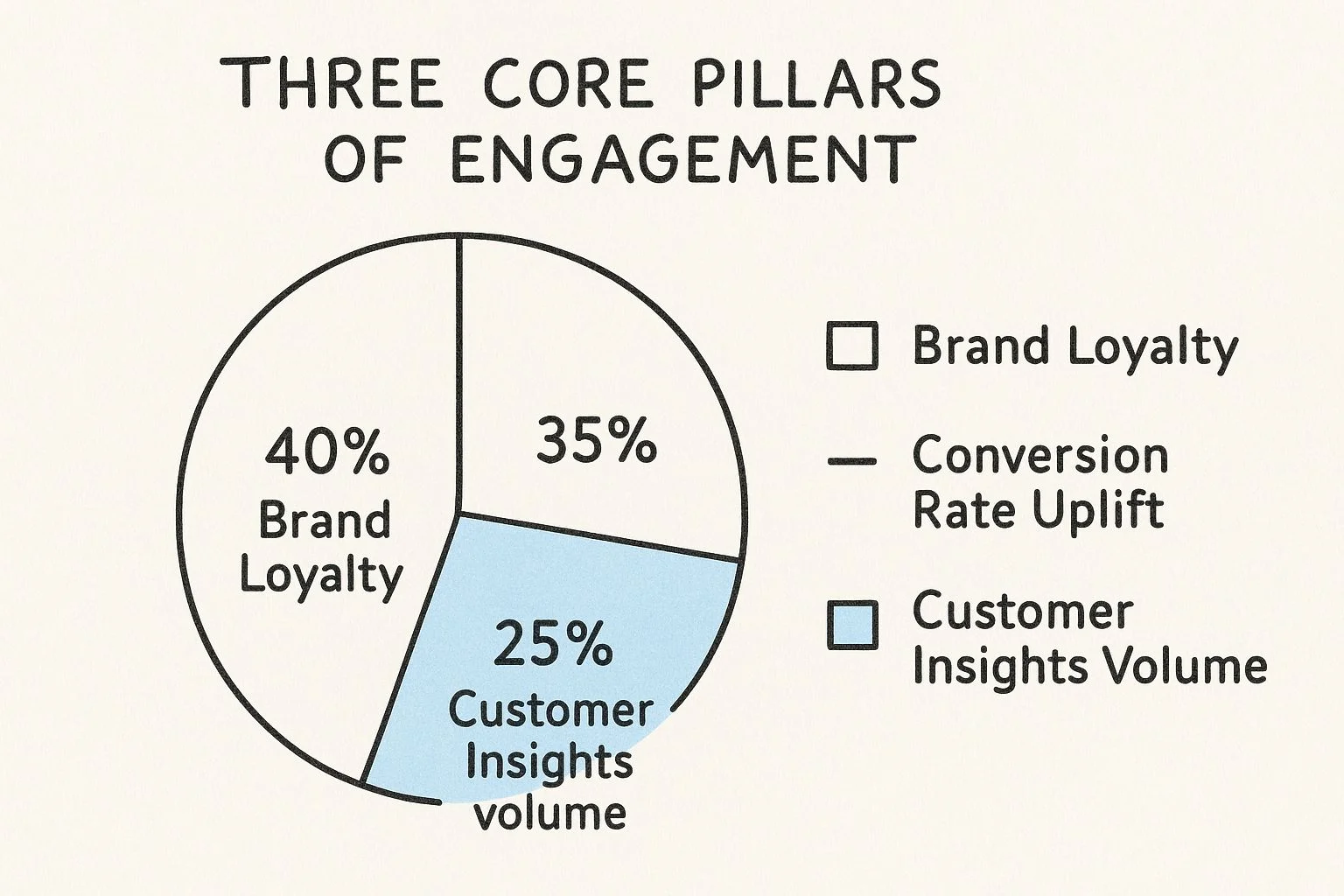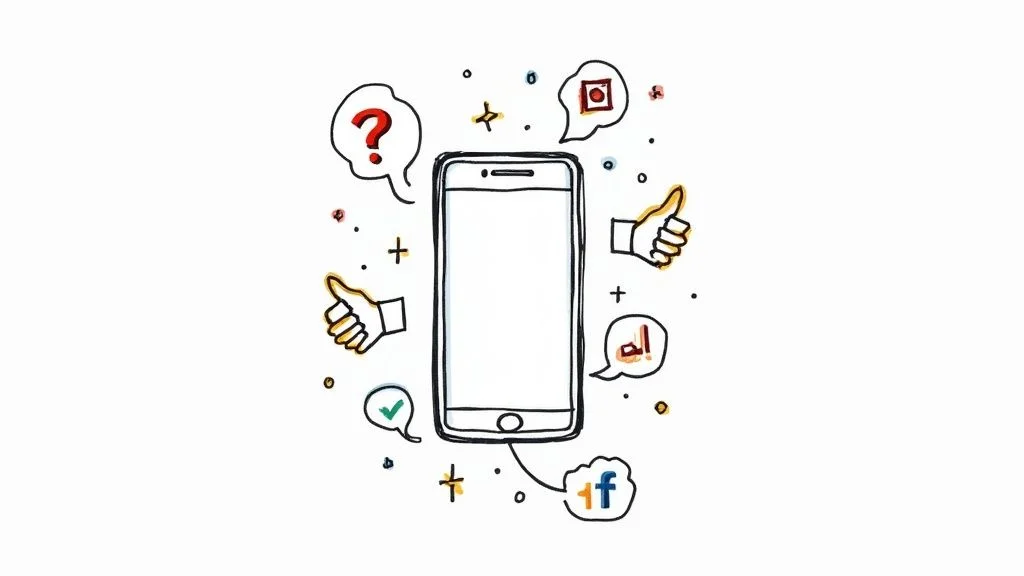How to Increase Social Media Engagement for Better Results
Learn how to increase social media engagement effectively. Build a loyal community and turn passive followers into active participants.

How to Increase Social Media Engagement for Better Results
If you want to get real results from social media, you have to stop chasing likes. It’s time to focus on what actually moves the needle: creating content that gets people talking and gives them something genuinely useful.
This means getting to know your audience, actually responding to their comments, and building a real community. It’s about turning people who just scroll past your content into active, engaged followers.
Why Engagement Is More Than Just Likes
Let's be real—vanity metrics like follower counts and likes feel good for a minute, but they don’t pay the bills. The metrics that truly matter are the ones that show people are paying attention: comments, shares, saves, and DMs.
These are the strongest signs that your brand is healthy and growing. They prove your content isn't just another post in the feed; it’s actually hitting home with your audience.
In a world of endless content, holding someone's attention is everything. Meaningful interactions are what change your social media profile from a megaphone into a community hub. Every thoughtful reply and every valuable post builds loyalty, one interaction at a time.
The Real Business Impact of Engagement
High engagement is a direct line to business growth. For starters, it’s a massive signal to the algorithms. When people interact with your posts, platforms like LinkedIn see your content as valuable and are far more likely to push it out to new people, boosting your organic reach for free.
But there's more. The comment section is a goldmine of customer feedback. The questions people ask and the discussions they have give you unfiltered insights into what they really want, need, and struggle with. You can't buy that kind of market research.
Engagement is the bridge between broadcasting your message and building a brand people genuinely care about. It's the difference between having an audience and having a community that advocates for you.
To get a clearer picture of what a solid engagement strategy looks like, it's helpful to break it down into its core components.
Core Pillars of High Social Media Engagement
This table sums up the fundamental strategies for boosting interaction, giving you a quick overview of the key topics we'll be diving into.
| Pillar | Key Action | Why It Works |
|---|---|---|
| Authentic Content Creation | Share valuable, relevant, and human-centric content. | Builds trust and positions you as a go-to resource, encouraging follows and shares. |
| Community Management | Actively respond to comments, messages, and mentions. | Makes your audience feel heard and valued, fostering a loyal community. |
| Consistency and Timing | Post regularly when your audience is most active. | Keeps your brand top-of-mind and maximizes the visibility of each post. |
| Interactive Elements | Use polls, questions, and calls-to-action (CTAs). | Directly invites participation and makes it easy for your audience to engage. |
Each of these pillars works together to create a flywheel effect, where great content sparks conversations that, in turn, inform your next piece of great content.
Visualizing the Core Pillars
This infographic breaks down exactly where a strong engagement strategy pays off. It's a clear split between fostering brand loyalty, driving actual conversions, and gathering those priceless customer insights.

As you can see, the single biggest benefit of consistent interaction is building brand loyalty (40%). And the opportunity here is massive. As of July 2025, there were around 5.41 billion social media users across the globe. You can dig into more stats on global social media usage over at datareportal.com to really grasp the scale of the connections waiting to be made.
Create Content That Sparks Conversation

Let's be real: if your content isn't starting a conversation, it’s just more noise in an already deafening feed. To really figure out how to increase social media engagement, you have to create posts that people can't help but react to. This isn't about just posting updates; it's about understanding what makes someone stop scrolling and type out a reply.
The secret? It all starts with value. Your audience doesn't care about your brand nearly as much as they care about what you can do for them. Does your post solve a nagging problem? Teach them a new skill? Offer a perspective they’ve never considered? Content that delivers genuine utility is what gets saved, shared, and talked about.
For instance, a marketing agency could drop a simple carousel post that breaks down a confusing SEO concept into three simple, actionable steps. That's instant value. It also positions them as a go-to expert and practically begs for questions and follow-up comments.
Ask Questions That Demand an Answer
One of the easiest ways to get a conversation going is… well, to ask for one. But there’s a catch. The quality of your question completely dictates the quality of the answers you'll get. Ditch the boring yes/no questions and start posing open-ended, or even slightly provocative, questions that need a real, thoughtful reply.
Try a few of these angles:
Go for experience: "What's the single best piece of career advice you've ever received?"
Stir the pot: "Hot take: Is a daily newsletter still the best marketing channel? Debate me in the comments."
Ask for help: "We're trying to name a new feature that does X. What would you call it?"
Questions like these flip the script. Suddenly, your audience is the expert, and it shows you actually care about their input. This small shift from broadcasting at people to talking with them is a game-changer for building a real community.
The goal is to make your followers feel like active participants, not a passive audience. When you ask for their stories, opinions, and creativity, you transform your feed into a collaborative space.
Weave a Narrative with Storytelling
Here’s a classic for a reason: facts tell, but stories sell. They also happen to be total engagement magnets. We're all wired to connect with a good story. Sharing the human side of your brand—the struggles, the wins, the lessons learned—forges an emotional connection that a simple "like" just can't touch.
A founder could share the raw story of a major business mistake and what they learned from it. That kind of vulnerability is instantly relatable. It often encourages others to jump in with their own experiences, creating a rich, authentic discussion right there in the comments. A good story makes your brand stick.
Master Different Content Formats
If you're only posting one type of content, you're leaving engagement on the table. People consume information differently, so you need a varied playbook to grab everyone's attention. It's worth exploring a bunch of content types to see what really clicks with your audience.
Video: Think behind-the-scenes clips, quick tutorials, or casual Q&A sessions.
Carousels: Perfect for breaking down complex ideas into bite-sized, swipeable slides.
Infographics: Turn boring data and stats into something people actually want to look at.
User-Generated Content (UGC): Why create everything yourself? Share posts from your customers and fans.
That last one—UGC—is especially powerful. When you feature a customer's photo or story, you're not just getting free content. You’re making that person feel seen and valued, which in turn inspires them (and others) to share more in the future. It’s a win-win that fuels itself.
Build an Unforgettable Online Community

Let's be real: genuine engagement isn't something you just wait for. It’s something you build, piece by piece, through dedicated community management. This is the work that turns casual followers into die-hard advocates for your brand.
It all starts in the comments section. Stop thinking of it as a chore and start seeing it for what it is—your number one spot for connection.
Every single comment, whether it's glowing praise or tough criticism, is a golden opportunity. When you acknowledge feedback, you're showing people you're actually listening. A thoughtful response can easily turn a neutral observer into a loyal fan. This is how you prove there's a real person behind the logo, building the trust that a strong community needs to survive.
Respond with Purpose and Personality
Just "liking" a comment? That’s a massive missed opportunity. If you're serious about boosting your engagement, you have to add something to the conversation. Your goal should be to make every single person who takes the time to comment feel seen, heard, and valued.
This means you’ve got to move past the generic, one-word replies. Forget "Thanks!" or "Great point!" Instead, ask a follow-up question. Offer a related tip. Share a quick personal story.
This is exactly what tools like Social Presence are built for. They offer AI-assisted comment starters that help you craft meaningful replies in seconds, so you can keep those high-quality interactions going even when you're swamped.
Got praise? Instead of just "Thank you!", try something like, "So glad this was helpful! What was your biggest takeaway?"
Got questions? Answer them directly and don't be stingy with the details. If you can, tag someone else who might find the answer useful.
Got criticism? Thank them for the feedback and tackle the concern head-on. Being transparent like this builds an incredible amount of trust.
Initiate Conversations and Spark Connections
Don't just sit back and wait for engagement to happen to you—get out there and create it. This means proactively starting conversations, not just on your own posts, but on others' as well. Use social listening to jump into relevant discussions in your industry and contribute real value, no sales pitch needed.
Just look at the rise of conversation-first apps like X (formerly Twitter) and Threads. It signals a huge shift in what people want online. Users are flocking to platforms that are all about timely news and genuine community, proving that your strategy needs to be about fostering real dialogue. Your audience is searching for connection, not just another piece of content.
Community isn't just about getting people to talk to you; it’s about getting them to talk to each other. A great community manager is a facilitator, connecting people with similar questions or interests right there in the comment threads.
This proactive approach is everything for growth. By consistently showing up and adding value, you’re not just boosting your visibility—you’re building a much stronger professional network. For a deeper dive on this, check out our guide on how to strategically increase your LinkedIn connections.
Make Your Followers Feel Valued
At the end of the day, an unforgettable online community is built on reciprocity. When your audience feels genuinely appreciated, they’re far more likely to engage with you consistently and tell others about you.
Think about running a few community-focused campaigns. You could feature a "Follower of the Week" or create a piece of content entirely based on user suggestions. These small gestures show that you see your followers as partners in your journey, not just numbers on a dashboard.
That authentic, human-to-human interaction is your most powerful and sustainable asset for growth.
Use Data to Find Your Engagement Sweet Spot

If you're still just guessing what to post and when, you're leaving engagement on the table. It's time to stop throwing content at the wall and start making decisions backed by your own data. The real secret to figuring out how to increase social media engagement isn't some universal formula—it's about digging into your own analytics to find out what your audience actually responds to.
Every single platform, from LinkedIn to Instagram, gives you a native analytics dashboard. Don't just glance at it for vanity metrics. This is a goldmine. Your first stop should be post performance. Look for patterns. Which days and times consistently bring in the most interaction?
Generic advice is a decent starting point, but your audience is unique. Maybe you'll find that your followers—mostly West Coast executives—are most active late at night, totally bucking the typical 9-to-5 posting wisdom. Our guide on the best times to post on social media can give you a baseline, but you have to let your own data have the final word.
Decode Your Content Performance
Beyond just timing, your analytics tell you which content formats are hitting the mark. Are your single-image posts getting more comments? Or do carousels drive more saves and shares? Knowing this helps you stop wasting creative energy on formats that don't perform.
And don't just focus on your greatest hits—your flops are just as important. A post with dismal engagement is a powerful lesson in what not to do. Maybe that text-heavy graphic was a dud, or a certain type of question just fell flat. This process of elimination is how you methodically sharpen your strategy over time.
Think of your social media analytics as a direct feedback loop from your audience. They are literally telling you what they want to see more of. All you have to do is listen and adapt.
Run Simple A/B Tests
Once you’ve got a handle on your baseline performance, you can start experimenting. "A/B testing" sounds technical, but it can be dead simple. The whole point is to change just one variable at a time to see which version performs better.
Here are a few easy A/B tests to get you started:
Captions: Post the same visual twice—once with a short, punchy caption and once with a longer, story-driven one.
Visuals: Test a high-quality stock photo against a custom-designed graphic or a candid photo of a person.
Calls-to-Action (CTAs): See what works better—a direct CTA like "Comment below with your answer" or a softer prompt like "What are your thoughts on this?"
This constant cycle of testing and learning is what separates the accounts that grow from the ones that stagnate. It turns content creation from a guessing game into a repeatable science.
Optimize for a Mobile-First World
Finally, never forget where your audience is seeing your content. With around 80% of all social media interactions happening on mobile devices, optimizing for small screens isn't just a good idea—it's mandatory.
This means using large, readable text on your graphics. It means formatting videos vertically. And it means breaking up your captions into short, scannable paragraphs so they don't look like a wall of text on a phone. The mobile experience is everything.
Master Platform Features and Trends
Every social media platform has its own language. If you want to boost your engagement, you have to become fluent.
Just splashing the same content everywhere is a surefire way to get ignored. To really connect with people, you need to speak the native language of each platform, and that means mastering its unique features and keeping up with the latest trends.
Here’s a little inside baseball for you: algorithms are built to reward users who play with their newest toys. When a platform launches a new feature, they really want people to use it. Jump on it early, and you’ll often get a nice little boost in organic reach for your trouble.
This means one of your best strategic advantages is simply staying curious and being willing to experiment.
Lean Into Platform-Specific Features
Generic content is invisible content. To get noticed, you have to tailor your posts to the environment. What kills it on LinkedIn will completely bomb on TikTok, and a killer Instagram Reel might just feel weird and out of place on Facebook.
Let’s break it down:
LinkedIn: This is where professionals hang out. Use LinkedIn Polls to get a read on industry trends or spark a debate with a sharp question. Don't just stick to text, either—try creating document carousels (just upload a PDF) to share deep knowledge. This is a great trick because it keeps people on your post longer, signaling value to the algorithm.
Instagram: It's all about the visuals here. You absolutely have to get comfortable with Instagram Reels for short-form video. Another powerful tool is Collaborative Posts, which lets you co-author content with a partner and instantly get in front of their audience. And don't sleep on interactive Story stickers—polls and quizzes are low-effort ways to get people tapping.
TikTok: This platform lives and breathes trends and audio. Participation is the name of the game. Get familiar with features like Duets and Stitches to add your own spin on popular content. Seriously, hopping on a trending sound within the first couple of days can give your visibility a massive shot in the arm.
Facebook: Community is still king on Facebook. If you can, build and nurture a Facebook Group for your niche. It creates a dedicated space for your biggest fans to connect, away from the chaos of the main feed.
When you master these features, you’re sending a clear signal to the algorithm that you’re creating quality, native content. In return, it rewards you with more reach. It's a simple give-and-take: you help the platform keep users on-site, and it helps you get seen.
Stay Ahead of Evolving Trends
The social media world moves incredibly fast. What worked last year might be totally useless today. You have to keep a finger on the pulse of emerging trends, otherwise your engagement strategy will go stale.
Right now, two huge shifts are changing how we all interact online.
First is the absolute dominance of short-form video. There's no getting around it. Platforms are pushing this format hard, making it one of the single most effective ways to reach new people.
Second is the rise of AI in creating content. Smart tools, like the AI-assisted comments you can find in Social Presence, are making it so much easier to keep up high-quality interactions without spending all day typing.
Adapting to these trends doesn't mean you have to throw out your entire strategy. It's about weaving them in intelligently. For instance, you could take a popular blog post and slice it up into a quick-tip Reel. Or you could use AI to brainstorm a week's worth of engaging questions for your next LinkedIn poll.
Building an engagement strategy that lasts means staying flexible, paying attention, and always being ready for what's next.
Your Top Social Media Engagement Questions, Answered
Even with the best game plan, you're going to have questions pop up while you're trying to figure out how to increase social media engagement. I get asked these all the time, so let's break down the most common ones to give you some real talk and set the right expectations.
How Long Until I Actually See Results?
This is the big one, isn't it? And the honest-to-goodness answer is: it depends.
But you're not flying blind. If you're consistently posting good stuff and jumping into conversations every single day, you'll often see little sparks within a few weeks—maybe a few more comments, a noticeable bump in shares. Those are your leading indicators.
For real, meaningful growth in your overall engagement rate, you need to give it at least 2-3 months of solid, dedicated work. The magic isn't in one viral post; it’s in the compound effect of showing up day after day. Trust me, tracking your metrics weekly is key here—it’ll show you the trend is moving up and keep you from getting discouraged.
Look, a slow start doesn’t mean your strategy is a bust. Building a real community is a marathon, not a sprint. The hard work you put in at the beginning pays off big time down the line with sustainable growth.
What Are the Common Mistakes I Should Avoid?
It's so easy to fall into a few classic traps when you're hungry for more engagement. One of the absolute biggest is "engagement baiting." You’ve seen it—posts that just beg for likes, shares, or comments without offering anything of value. The algorithms are wise to this, and it’ll tank your reach.
Another classic mistake is only playing defense. If you only reply to the glowing comments and ignore tough questions or criticism, you’re basically telling people you don't care about real feedback. Engaging with everyone, the good and the bad, shows you're authentic and not afraid of a real conversation.
And finally, don't be a ghost. Posting once in a blue moon or vanishing for weeks at a time completely kills your momentum. Consistency is the engine of engagement. Without it, you’re making it impossible for your audience to get in the habit of interacting with you.
Should I Be on One Platform or All of Them?
When you’re just starting, trying to be everywhere at once is a surefire recipe for burnout and weak, watered-down content. It's so much more effective to master one or two platforms where you know your people are actually hanging out. Go deep, not wide.
Really learn the quirks of that platform. Build a solid, loyal crew there. Get a content system down that you can actually manage without losing your mind. Once you have a thriving presence and a process that works, then you can think about expanding to another platform. This focused approach means you’re always delivering quality, not just quantity.
Ready to stop guessing and start connecting on LinkedIn more efficiently? Social Presence gives you the tools to show up consistently, from AI-assisted comments to personalized feeds that cut through the noise. Start saving time and boosting your visibility today at https://socialpresence.co/en.